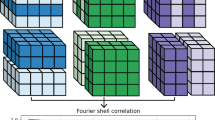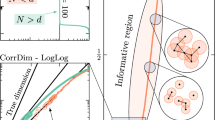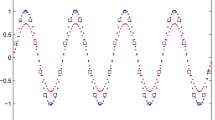Abstract
A new method of three-dimensional image reconstruction from electron micrographs is presented here, which enables a three-dimensional image to be produced from a single oblique section of a two- or three-dimensional crystal. The method, which is most powerful when the section is thin and the angle of obliquity small, has several potential advantages over the conventional method of reconstruction1 using tilted views of the section. In particular the accumulated electron dose on the specimen is much smaller and the reconstruction is not affected by changes in the thickness of the section during exposure to the electron beam. The method involves the solution of a generally almost singular set of linear projection equations2, relating through the sectioning geometry the three-dimensional crystal density to the two-dimensional projected image density. This can be achieved most conveniently by linear least squares filtering3. An application of the method to determine the structure of the M-band of fish muscle is described. The resulting map agrees well with that produced by the more conventional approach involving tilted views4.
This is a preview of subscription content, access via your institution
Access options
Subscribe to this journal
Receive 51 print issues and online access
$199.00 per year
only $3.90 per issue
Buy this article
- Purchase on Springer Link
- Instant access to full article PDF
Prices may be subject to local taxes which are calculated during checkout
Similar content being viewed by others
References
Amos, L. A., Henderson, R. & Unwin, P. N. T. Prog. Biophys. molec. Biol. 39, 183–231 (1982).
Crowther, R. A., DeRosier, D. J. & Klug, A. Proc. R. Soc. A317, 319–340 (1970).
Diamond, R. Acta crystallogr. 11, 129–138 (1958).
Luther, P. K. & Crowther, R. A. Nature 307, 566–568 (1984).
Klug, A. & Crowther, R. A. Nature 238, 435–440 (1972).
Squire, J. M. in The Structural Basis of Muscular Contraction 332–343 (Plenum, New York, 1981).
Luther, P. K., Munro, P. M. G. & Squire, J. M. J. molec. Biol. 151, 703–730 (1981).
Strehler, E. E., Carlsson, E., Eppenberger, H. M. & Thornell, L-E. J. molec. Biol. 166, 141–158 (1983).
Crowther, R. A. & Sleytr, U. B. J. ultrastruct. Res. 58, 41–49 (1977).
Author information
Authors and Affiliations
Rights and permissions
About this article
Cite this article
Crowther, R., Luther, P. Three-dimensional reconstruction from a single oblique section of fish muscle M-band. Nature 307, 569–570 (1984). https://doi.org/10.1038/307569a0
Received:
Accepted:
Issue Date:
DOI: https://doi.org/10.1038/307569a0
This article is cited by
-
Myofibrillar M-band proteins represent constituents of native thick filaments, frayed filaments and bare zone assemblages
Journal of Muscle Research and Cell Motility (1985)
-
Three-dimensional reconstruction from tilted sections of fish muscle M-band
Nature (1984)
Comments
By submitting a comment you agree to abide by our Terms and Community Guidelines. If you find something abusive or that does not comply with our terms or guidelines please flag it as inappropriate.



